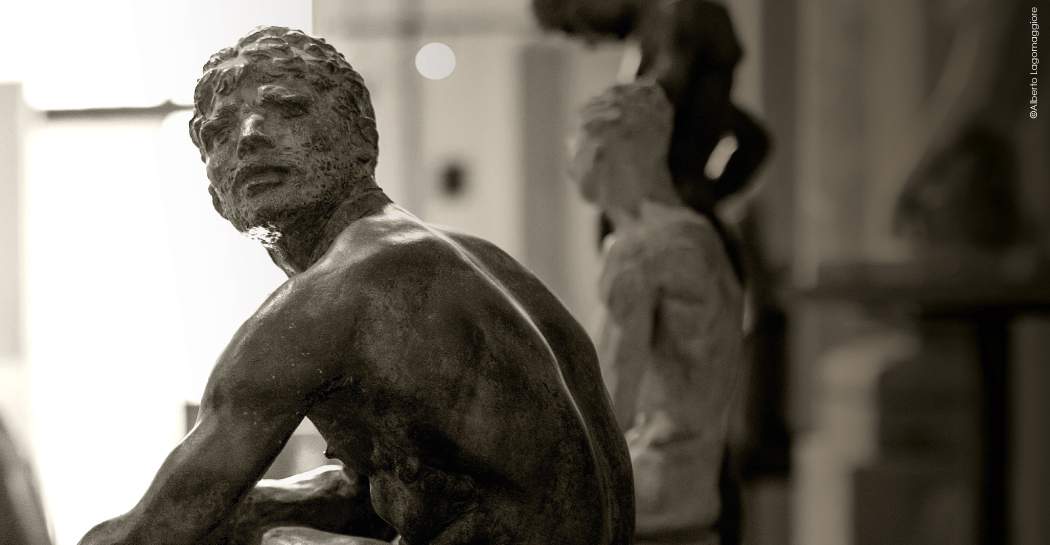Villa Torlonia in Rome presents, through Sept. 4, the exhibition Francesco Messina. Novecento Contemporaneo, a rich selection of bronzes, terracottas and plaster casts depicts the vital relevance of the master’s art between tradition and modernity. The exhibition offers the public the activity of Francesco Messina (Linguaglossa, 1900 - Milan, 1995) and the Milanese Studio Museum that bears his name, representing both the relationship with tradition - classical, Renaissance and nineteenth-century - and the dialogue with contemporaneity, thus restoring the still vital and stimulating topicality of the sculptor’s work and the profound sense of the enhancement activity that the Francesco Messina Studio Museum has conducted since 2014, first and foremost, through its exhibition activity.
Francesco Messina, Sicilian by birth but Milanese by adoption, outlines from the very beginning of his artistic career a precise orientation toward the great artistic tradition of figure sculpture, with the use of classical techniques and materials - bronze, marble, wax, terracotta, plaster - intercepting the taste of a public distant from the most daring experimentation, which also follows him in the most famous Italian magazines after World War II. Despite the constant reference to the tradition of the artist’s entire production, the exhibition Francesco Messina. Novecento Contemporaneo does not return the profile of a sculptor entrenched in a feeling of nostalgia toward a remote past from which to draw suggestions and contaminations, but conversely reconstructs a dynamic personality who, in each season, has been able to mature a new approach to tradition, from time to time reworked and adapted to the language of his own time, and who has shown, in his production, to be able to anticipate research later developed in more recent times.
The exhibition wants to be considered a test case to verify this specific vocation of the artist, that is, his belonging to a timeless time, as a conscious custodian of the ancient craft of making sculpture. To this end, 81 works (mainly bronzes, terracottas and plaster casts) belonging to the permanent collection of the Francesco Messina Studio Museum and works by fifteen contemporary artists(cyop&kaf, Vanni Cuoghi, Salvatore Cuschera, Giovanna Giachetti, Alberto Gianfreda, Andi Kacziba, Giulia Manfredi, Francesco Merletti, Daniele Nitti Sotres, Francesca Piovesan, Nada Pivetta, Dominique Robin, Daniele Salvalai, Elisabeth Scherfigg, Andreas Senoner), which confront Francesco Messina’s sculptures and illustrate, by significant stages, the programmatic line and theenhancement activities conducted by the Studio Museo in recent years.
The permanent collection - selected, in its main nucleus, by Messina himself in the mid-1970s, at the time of the birth of the Studio Museo - summarizes the artist’s production in an articulate way, embracing a chronological span that, from the 1930s, reaches the early 1980s.
This nucleus includes emblematic works that are exhibited at Villa Torlonia: the castings from the originals that, in the 1930s, were selected by the Venice Biennale to representItaly in the exhibitions abroad organized by Antonio Maraini (such as Bambino al mare, 1935); the portraits that restore the cultural climate of the years between the two wars (such as the Portrait of Salvatore Quasimodo, 1937); the sketches for important monumental commissions (the series of horses that preceded the creation of the 1966 RAI Horse, the sketches for the Monument to Pius XII in St. Peter’s); the female sculptures in terracotta and polychrome plaster from the 1970s.
The Roman exhibition is divided into sections that revolve around the main themes of Messina’s research: the portrait between archaeology and contemporaneity, the approach to tradition with a modern gaze, anatomical investigation, color, and monumental sculpture. The itinerary is enriched by two video-interviews from 1973 showing Francesco Messina inside the Studio Museo(Io e... by Anna Zanoli, in which the sculptor recounts his relationship with Michelangelo ’s Pietà Rondanini and Incontri - Fatti e personaggi del nostro tempo in which Messina, interviewed by Franco Russoli, makes a clay sketch).
Curated by Maria Fratelli, Chiara Fabi and Chiara Battezzati, it is promoted by Roma Culture, Sovrintendenza Capitolina ai Beni Culturali in collaboration with the City of Milan and Studio Museo Francesco Messina.
For all information, you can visit the official website of Villa Torlonia.
Photo by Alberto Lagomaggiore
 |
| Rome, at Villa Torlonia the sculptural works of Francesco Messina |
Warning: the translation into English of the original Italian article was created using automatic tools. We undertake to review all articles, but we do not guarantee the total absence of inaccuracies in the translation due to the program. You can find the original by clicking on the ITA button. If you find any mistake,please contact us.